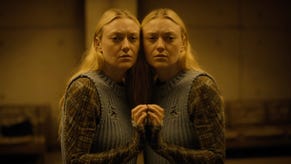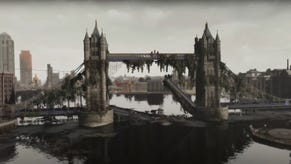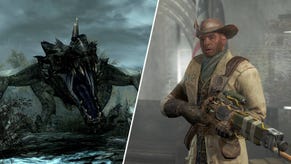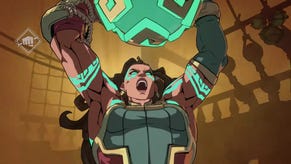Lara is dead, long live Lara: Tomb Raider at E3
Tomb Raider's revival was one of Microsoft's big press conference tickets and is likely to be one of the biggest games of the next 12 months. Stace Harman speaks to art director, Brian Horton in LA.
“We wanted to keep the same tenants of an action-adventure game but put them through a new filter and so the origin story bubbled up from that. By having a period of incubation, we’ve been able to revitalise not only the tone and mood of the game, but also the mechanics and the way the game plays in order to make it more relevant for today’s gamer.”
Following its appointment to the franchise, Crystal Dynamics released three Tomb Raider titles in successive years as it sought to return Lara to her glory days. It had a great deal of player-apathy to combat that, somewhat ironically, had itself been brought about by half a decade of annual releases, later followed by the coup de grâce that was Angel of Darkness.
But whilst Legend, Anniversary and Underworld were all solid experiences in the classic Tomb Raider mould, they felt like the output of a developer paying homage to a bygone era; a developer that was biding its time before breaking free of its shackles to craft its own vision of both game and leading star.
“We’d done all that we could do with that version of Tomb Raider and we needed to think about Lara in a fresh way,” confirms Crystal Dynamics art director, Brian Horton. “We wanted to keep the same tenants of an action-adventure game but put them through a new filter and so the origin story bubbled up from that.
“By having a period of incubation, we’ve been able to revitalise not only the tone and mood of the game, but also the mechanics and the way the game plays in order to make it more relevant for today’s gamer.”
It’s true that Lara is not the woman she was all those years ago, at least not in the gameplay we’re shown from the beginning of the game. Where once she somersaulted over adversaries, targeting them with her twin pistols, she now hides from them, runs away, or at best, tries for a swift and silent kill with her bow and arrows. Her cocksureness and debonair air have been replaced by panic and desperation, her movements in the opening 20 minutes are often inelegant and faltering.
On account of this relegation to mere human, Lara’s prospects of survival appear bleak as she goes about trying to start a fire, drinking rain water and forage for food. But as she completes these tasks she begins to earn survival XP, a first for the Tomb Raider series and appropriately indicative of Lara having to learn skills that her older, more experienced self takes for granted.
This XP is spent on manually upgrading survival skills, which takes place at bonfires and brings to mind a game with its own take on survival, Dark Souls. As with From Software’s sadistic masterpiece, camp fires fulfil the role of a hub at which to administer character development and upgrade or repair equipment, but they also act as a beacon of hope and a marker of solace.
As Horton upgrades Lara’s skill-set with the ability to identify and obtain edible plants, it brings into focus a feature that will prove divisive and about which I have an uneasy feeling: Survival Instinct. This is pretty much exactly what you might expect: it’s the ability for Lara to view her environment through the eyes of a survivor which means being able to highlight useful items or give an indication of the direction in which she should be heading. Slightly concerned by this, I ask Horton whether the inclusion of Survival Instinct marks the end of having to work out for yourself where to go or what to do next.
“Survival Instinct is opt-in and is really just a hint system,” he explains, reminding me of the tiered, menu-based hint system of Underworld. “It just points you in the right direction, rather than telling you what to do next.
“The player is free to navigate the environment in multiple ways and there are an awful lot of nooks and crannies you can explore. The explorers out there are going to love it; on their own, just Lara and the player exploring what the story, island and Lara herself.”
From initial viewing, it doesn’t appear to be a crutch that spoils the feeling of exploration, but there’s little narrative justification for its inclusion and it will be left up to the player’s willpower to resist the temptation to activate it and take a sneaky peek. Which leads us, neatly but regrettably, on to two words I’d hoped to avoid.
“Cleavage shots”
Unfortunately, these two words are amongst the first that I write on my notepad whilst watching Horton guide Lara through the early stages of the game. They’re prompted by a cut-scene in which the future Lady of Croft manor is speaking in quiet, desperate tones, pleading with her missing mentor, Conrad Roth, to come find her because she’s just not sure that she can survive on her own. As Lara exposes her vulnerability, we’re “treated” to an over the shoulder camera shot which clearly, distractingly and unnecessarily exposes her cleavage and if Survival Instinct is a new feature that people might object to, gratuitous shots of Lara’s cleavage is an unwelcome throwback to the Tomb Raider of old.
“Survival Instinct is opt-in and is really just a hint system. It just points you in the right direction, rather than telling you what to do next."
More welcome, is the revealing of Lara’s other assets; ones that serve to aid her survival: the bow and arrow, a weapon that’s fast becoming synonymous with new-look-Lara, serves as both a weapon and a tool as Lara first brings down a deer, before using an arrowhead to shear meat from its carcass. Similarly, the pry axe is shown being used to leverage a door, before its wooden handle must be upgraded to render it strong enough to be used as a crank to gain access to a new path into an unexplored environment.
The environment itself looks an appealing mix of dense foliage, broad jungle canopies and undulating terrain which manages to look idyllic in daylight and imposing in the darkness. The terra firma assumes its own dual-personality, at once Lara’s playground and her prison, reinforced by a weather system that Horton says is not simply for aesthetic value, but to add an additional dimension to Lara’s plight.
“It’s essential that the weather and environment conditions tie into Lara’s story, be it to reinforce an emotion or to act as a counterpoint to that emotion,” he explains. “We have a lot of peaks and valleys, so you’re going to see those rays of hope coming through, but then we’re going to break it back down again. The colour palette and the weather play a big part in reflecting and determining the emotional state of Lara and of the situations that the player finds them self in.”
Both Tomb Raider and Lara herself have come a long way since their inception, 16 years ago – although, in the area of Lara as a sex-object that progress has perhaps not been as extensive as one might have hoped. When she returns next March, we’ll discover whether her metamorphosis from outdated relic to relevant heroine has been successful and whether Crystal Dynamics has done her heritage proud.
Tomb Raider launches worldwide for for 360, PS3 and PC on March 5 2013.











